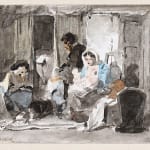-


Thomas Faed ARSA RA
From dawn to sunset, first thoughts, c.1860signed; inscribed by the artist on label verso: 'From dawn to sunset - first thoughts'watercolour3 ½ x 5 ¾ inchesProvenance
The Fine Art Society, November 1977, no. 35/14091Exhibitions
The Fine Art Society, London & Edinburgh, November 1977 (An oil sketch of this subject was exhibited at RSA 1864, No. 348)




